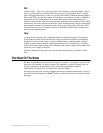
Chapter 1 - Intercoms—An Overview 1
C HAPTER
1
C
HAPTER
1
I
NTERCOMS
—A
N
O
VERVIEW
RALPH STRADER
Introduction
Intercom systems, by definition, may be comprised of many different types of intercoms
and subsystems. The basic building blocks can be categorized into four basic types or
elements: Party-Line Systems, Matrix Systems, Wireless Systems, and Accessories.
Party-Line Systems
Wired Party-Line systems are systems in which a number of participants are all involved
in the same conversation. Think of the telephone extensions in your home, if each person
in your family picks up a telephone in your home, you will all be able to hear each other.
You can talk to one another simultaneously and the person “on the other end of the line”
will be a full participant in one “public” conversation.
Depending on where in the world you are from, (presuming English language), you may
also refer to this type of system as “PL” (for “party-line), “TW” or “Two-Wire” from the
telephone systems, where on two wires, a full duplex conversation takes place, or
“conference” denoting the type of activity taking place in the conversation.
Figure 1.1
Simple Party-Line System
Note, the physical configuration and implementation of that “PL” or “TW” does not
necessarily need to be on two physical wires, in most cases it is not. The specific
topologies will be addressed in the chapters that follow.


















